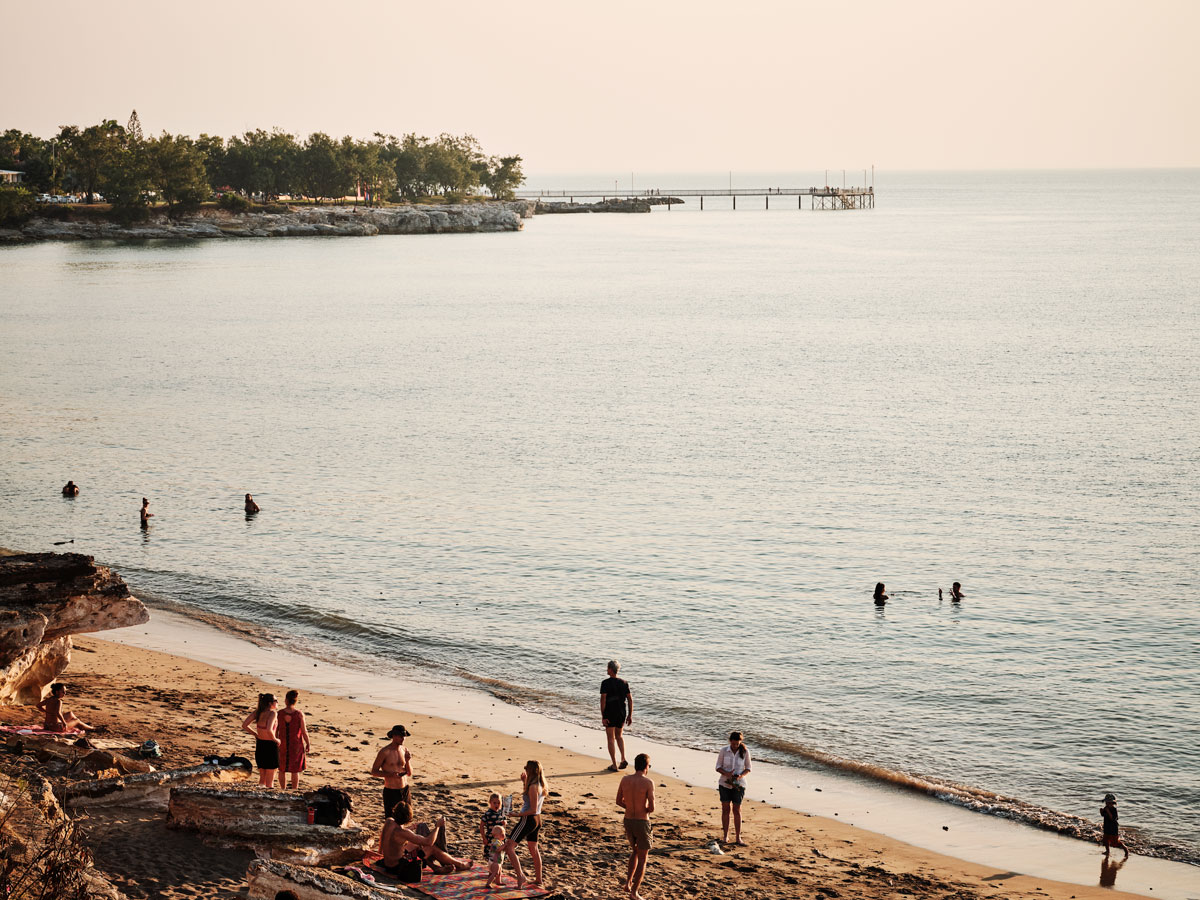02 April 2025
![]() 5 mins Read
5 mins Read

The risks? Crocs and stingers – because, well, this is the Top End. But on a dry season weekend, you’d be forgiven for thinking you’ve teleported to Bondi Beach, with 30 or so people splashing about at Nightcliff Beach and plenty more braving the ocean at Casuarina for a proper swim.
Swimming at the beach in Darwin is a personal call. Weigh up the risks, get informed, stick to patrolled areas when surf lifesavers are on duty, wear protective gear if it makes you feel better – and jump in if it feels right.
Here’s the lowdown on where you can swim, where to stay dry and how to enjoy Darwin’s blue waters safely.

Nightcliff Beach is one of the patrolled beaches in Darwin that is considered safe for swimming. (Image: Jeremy Simons)
Zero stress, zero surprises? Head to Darwin Waterfront Lagoon. It’s man-made, croc- and jellyfish-free and patrolled all year. There’s even a netted section and grassy banks for lounging. The Wave Pool is nearby, with timed swells for boogie boarding. It’s the safest splash you’ll find.
From June to August, things shift. The water’s clearer, jellyfish numbers drop and locals start dipping their toes – and more – in the ocean.

The picturesque Nightcliff Beach feels like a hidden gem. (Image: Jeremy Simons)
At high tide, Nightcliff Beach is magic. The water turns turquoise, locals swim and wade, and confident swimmers jump from the rocks (safely). The Darwin Surf Life Saving Club patrols on Sundays during the dry season, and there’s a laid-back vibe that makes it feel like a hidden gem.
Early riser? Join the Wednesday Dippers at 6.30am for a group swim and post-dip coffee at The Foreshore Restaurant & Cafe. Want to float instead of swim? Hire a paddleboard from Fun Supply.

Witness a pretty, pink-hued sunset at Casuarina Beach. (Image: Tourism NT/ James Maddock)
Part of the Casuarina Coastal Reserve, this wide 4.5km beach is home to Darwin Surf Life Saving Club and its little nippers’ training sessions (Sundays, June to September). It’s also where ocean swims happen each August, with lifesavers patrolling on boards and watercraft.
No rock jumping here – just calm waves and wide-open space. After your swim, refuel at De La Plague Cafe – one of the city’s best spots for post-beach brunch.

Soak up magnificent sunsets at Mindil Beach. (Image: Tourism NT/Sean Scott)
People do swim at Mindil Beach during the dry season, but let’s be honest – you’re really here for the Mindil Beach Sunset Markets. Lifeguards patrol from 2pm to 6pm, Thursday to Sunday (and during incoming tides earlier in the week). Grab a laksa, sit on the sand, and soak up that famous sunset – swimming optional.

East Point Beach is surrounded by dense and thick mangroves. (Image: Tourism NT)
Patrolled by Mindil Beach Surf Life Saving Club on Sundays in the dry season, East Point Beach is part of the East Point Recreation Reserve, a curved 1.5km stretch ending in mangroves and rocky outcrops. Bonus: Lake Alexander is right behind the beach, offering a croc-free alternative if you’re not keen on the ocean.
Box jellyfish and Irukandji are no joke. They’re dangerous, sometimes deadly, and hard to spot. Stinger season runs from October to May, but stings have happened year-round. Kids are more at risk, and since 1975, all 14 recorded stinger-related deaths in the NT have been children.
Box jellyfish are clear with a boxy body and long venomous tentacles and their stings can be fatal. Irukandji (a group of smaller, highly venomous species) are tiny, but nasty. Some species are only the size of a thumbnail. If stung pour vinegar on the area (not fresh water) and call 000 or find a lifeguard.

Darwin is home to dangerous saltwater crocodiles. (Image: Caroline Brundle Bugge)
Yes, saltwater crocs live in Darwin’s waters, but there hasn’t been a fatal attack at these beaches in over 120 years. Why? Because lifesavers manage the risks and beaches close immediately if crocs are spotted. But always check the water before you enter when swimming at the beach. Any natural body of water in the Top End may contain large and potentially dangerous crocodiles.

Nightcliff Beach is moderately steep and narrow at high tide. (Image: Tourism NT)
Darwin has some of the biggest tidal shifts in the country, with changes of up to eight metres between low and high tide. At low tide, beaches can turn into vast stretches of exposed mudflats, making swimming tricky (and unappealing). High tide is your best bet – the water is deeper, clearer, and safer, with fewer sharp rocks and critters underfoot.
Discover the best things to do in Darwin
LEAVE YOUR COMMENT